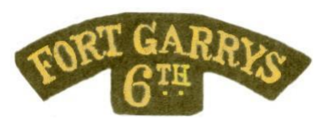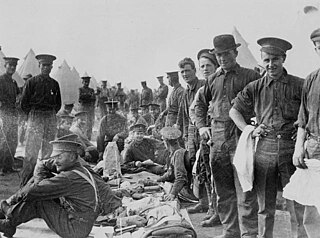Related Research Articles

The Royal Highland Fusiliers of Canada is a Primary Reserve light infantry regiment of the Canadian Army, with companies in Cambridge and Kitchener, and is an infantry sub-unit of 31 Canadian Brigade Group, headquartered in London, Ontario. The Princess Margaret, Countess of Snowdon, and The Prince Andrew, Duke of York, as members of the Canadian Royal Family, acted as Colonel-in-Chief.
The 138th Battalion, CEF, was a unit in the Canadian Expeditionary Force during the First World War.
The 202nd (Sportsmens) Battalion, CEF was a unit in the Canadian Expeditionary Force during the First World War. Based in southside Edmonton, Alberta, the unit began recruiting during the winter of 1915/16 in that city and surrounding district. It was formally authorized on July 15, 1916. Its headquarters were in the Sheppard Block at 10316 Whyte Avenue.

The 12th Manitoba Dragoons is an armoured regiment of the Canadian Army that is currently on the Supplementary Order of Battle.

The 19th Alberta Dragoons was a cavalry regiment and later an armoured regiment of the Canadian Militia and later the Canadian Army. It was placed on the Supplementary Order of Battle in 1965. In 2006, it was taken off the Supplementary Order of Battle and amalgamated with the South Alberta Light Horse.

The 29th Battalion (Vancouver), CEF was an infantry battalion of the Canadian Expeditionary Force during the Great War.
The 12th Battalion, CEF was an infantry battalion of the First World War Canadian Expeditionary Force.
The Edmonton Fusiliers was an infantry regiment of the Non-Permanent Active Militia of the Canadian Militia and later the Canadian Army. First raised in 1908 as part of the 101st Regiment Edmonton Fusiliers, it became a separate regiment in 1924 when The Edmonton Regiment was split into two separate regiments. In 1946, the regiment was Amalgamated with the 19th Alberta Dragoons.

The 5th Battalion, CEF, known as "Tuxford's Dandys," was an infantry battalion of the Canadian Expeditionary Force during the Great War.

The 6th Battalion, CEF was a battalion of the Canadian Expeditionary Force during the First World War.

The 11th Battalion, CEF, an infantry battalion of the Canadian Expeditionary Force, was authorized on 10 August 1914 and embarked for Great Britain on 30 September 1914. It was redesignated as the 11th Reserve Infantry Battalion, CEF, on 29 April 1915, to provide reinforcements to the Canadian Corps in the field. On 4 January 1917, its personnel, along with the personnel of the 100th Battalion, CEF, were absorbed by a new 11th Reserve Battalion (Manitoba), CEF. The battalion was disbanded on 12 October 1917.
The Canadian Fusiliers (City of London Regiment) was an infantry regiment of the Non-Permanent Active Militia of the Canadian Militia (now the Canadian Army). In 1954, the regiment was amalgamated with The Oxford Rifles to form The London and Oxford Fusiliers (now the reserve battalion of the Royal Canadian Regiment).
The 17th Battalion, CEF was a battalion of the Canadian Expeditionary Force during the Great War.
The 32nd Battalion, CEF, was an infantry battalion of the Canadian Expeditionary Force during the Great War.

The 51st Battalion (Edmonton), CEF, was an infantry battalion of the Canadian Expeditionary Force during the Great War. The 51st Battalion was authorized on 7 November 1914 and embarked for Great Britain on 18 April 1916. It provided reinforcements for the Canadian Corps in the field until 13 November 1916, when it was reorganized as a garrison duty battalion. On 22 June 1917, its personnel were absorbed by the various regimental depots. The battalion was disbanded on 15 September 1920.
The 63rd Battalion (Edmonton), CEF, was an infantry battalion of the Canadian Expeditionary Force during the First World War. The 63rd Battalion was authorized on 20 April 1915. During its recruitment phase the battalion sent three reinforcing drafts to England on 11 September 1915, 22 January and 2 March 1916. The battalion as a whole embarked for Great Britain on 22 April 1916. It provided reinforcements for the Canadian Corps in the field until 7 July 1916, when its personnel were absorbed by the 9th Reserve Battalion, CEF. The battalion was subsequently disbanded on 1 September 1917.
The 66th Battalion, CEF was an infantry battalion of the Canadian Expeditionary Force during the First World War. The battalion was authorized on 20 April 1915 and embarked for Britain on 28 April 1916. Its personnel were absorbed by the 9th Reserve Battalion, CEF on 7 July 1916 to provide reinforcements for the Canadian Corps in the field. The battalion was disbanded on 30 August 1920.
The 15th Battalion, CEF was an infantry battalion of the Canadian Expeditionary Force during World War I. The 15th Battalion was authorized on 1 September 1914, embarked for Britain on 26 September 1914, and arrived in France on 15 February 1915. The battalion fought as part of the 3rd Canadian Brigade, 1st Canadian Division in France and Flanders throughout the war. The battalion was disbanded on 30 August 1920.

The 89th Battalion (Alberta), CEF, was an infantry battalion of the Great War Canadian Expeditionary Force. The 89th Battalion was authorized on 22 December 1915 and embarked for Britain on 2 June 1916, where its personnel were absorbed by the 9th Reserve Battalion, CEF, to provide reinforcements for the Canadian Corps in the field. The battalion disbanded on 21 May 1917.

The 113th Battalion, CEF, was an infantry battalion of the Great War Canadian Expeditionary Force. The 113th Battalion was authorized on 22 December 1915 as part of a recruiting drive in which men from the same region could enlist and serve together.
References
- ↑ "CEF Infantry Battalions" (PDF).
- ↑ "9th Battalion, CEF". www.canadiansoldiers.com. Retrieved 2022-02-20.
- 1 2 "The South Alberta Light Horse". Official Lineages Volume 3, Part 1: Armour, Artillery and Field Engineer Regiments - Armour Regiments. Directorate of History and Heritage. Archived from the original on 25 February 2012. Retrieved 8 April 2017.
- 1 2 3 Meek, John F. Over the Top! The Canadian Infantry in the First World War. Orangeville, Ont.: The Author, 1971. ISBN 0906158109
- ↑ Appendix to General Order No. 123 of 1929
- ↑ Defence, National (2019-07-22). "WWI - The Great War". www.canada.ca. Retrieved 2023-02-10.